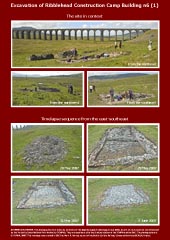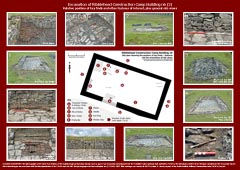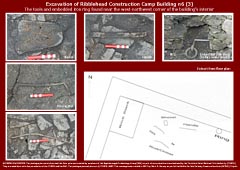The excavation
In 2007 the Yorkshire Dales National Park Authority (YDNPA) asked the Ingleborough Archaeology Group (IAG) to undertake a 'mitigation programme' for the archaeological remains of 'building n6' (one of the structures within the Ribblehead Construction Camp). The aims and objectives of the mitigation programme were to:
- remove existing rubble within the stone spread to reveal the structure’s external form,
- expose any external wall lines and internal features,
- provide a detailed record of the structure,
- attempt an interpretation of the structure and to suggest its original functions,
- backfill on completion and leave in a secure manner with wall lines exposed.
This 'destructive' intervention was deemed necessary because a Monuments At Risk Survey in 2005 found evidence that the site (which lies within a Scheduled Ancient Monument) had been illegally disturbed.
The excavation took place between Monday 28th May and Thursday 31th May, 2007 and it yielded a significant number of finds, most notably:
- 116 items of metalwork including
- 106 nails,
- a ferrous metal window stay,
- a ferrous metal knife with a bone handle (interpreted as a kitchen-type knife),
- an 88mm by 40mm hammer wedge,
- a severely corroded small coal shovel with handle, and
- two wrought-iron hoops (one from a wooden barrel, the other from either a small barrel or a wooden bucket).
- 113 ceramic items, including
- part of china saucer with a ‘Chinoiserie’ pattern,
- part of a straight-sided jug made of white earthenware,
- part of a large bowl-like vessel composed of beige slip on a red fabric,
- a complete brown stoneware glazed inkwell, and
- fragments of earthenware bottles and jars.
- 51 glass items, including
- large quantities of thin, clear window glass,
- an almost complete, two-piece machine-moulded, clear glass phial,
- part of a machine-made sugar bowl, and
- various fragments of bottle glass.
- 129 bones / bone fragments, including
- Sheep or goat (20)
- Cow (15)
- Pig (16)
- Deer (1)
- Cat (4)
- 4 fragments of clay pipe, and
- 24 other items.
The excavation also uncovered two stacks of bricks inside the building:
- "In the north-west corner of the building there was a neat, though slightly collapsed, pile of ordinary red brick, laid alternately as headers and stretchers."
- "In the south-west corner there was a single row of similar brick laid as stretchers parallel to the west gable wall."
After the excavation and recording work had been completed, the site was backfilled by hand. "The project brief required the backfill to be levelled off leaving a 'stable, interpretable structure' with 'small sections of wall' left exposed for the long-term."
The three photo-montages below include a small selection of the digital photographs taken during the excavation process.
(Tip: To view larger versions, click / tap on the thumbnails.)
The interpretation: Part 1 - Form
The building was broadly oblong in plan.
The rear (north) wall was the sturdiest, while the front (south) wall "was footed on very small stone; and the two gable walls were of poor quality build, especially at the southern ends. It is believed, therefore, that the building had a monopitch roof: the gable walls were too narrow to have supported a wall reaching to full ridge height." The team concluded that the roof probably sloped downwards from rear to front, perhaps to reduce the impact of the prevailing south-westerly winds.
The front wall included a wide doorway and a glazed window.
The interior floor was covered with stone and "a small sump drain . . . capped with a cast-iron grid cover measuring 220mm by 220mm" was set into the floor just inside the doorway. "The sump drained out of the doonway beneath the wooden threshold. . . . The eastern section of flooring differed markedly from the western, though it was all composed of limestone blocks of uneven and varying sizes. For almost 2.50m from the east gable wall, extending from the rear to the front wall, all the stone blocks had been inserted vertically with their long edge forming the floor surface. To even this off, crevices between individual blocks had been packed with lime mortar and the entire surface had been similarly coated with lime mortar. It is known that such treatment limits rising damp within buildings. The remaining 6.60m of floor, again extending for the full depth of the building, had a floor composed of limestone blocks laid horizontally to give a more or less even surface. Between larger blocks small pieces of stone had been packed in to seal the gaps. Approximately 2.20m to 2.80m from the west gable, extending for almost 3m from the rear wall, there was a possible patterning of the flooring blocks."
"Set into the rear (north) wall was what proved to be the building's most perplexing feature. A sturdy cast-iron ring, pivoted on the end of a long cast-iron bar, had been built into the wall during its construction 4.12m from the western end of that wall, and 190mm from the floor. The bar extended right through the rear wall, was then braced by a vertically-set wooden batten laid against the wall's exterior face, and then extended into the natural banking behind the building. How far it extended could not be determined. The bar had a thickness of 30mm as did the fixed ring at the end which had an internal bore of 40mm. Threaded onto this fixed ring was the free-swinging ring, also with a diameter of 30mm but with an internal bore diameter of 100mm. It was clearly meant to restrain or secure something either very valuable or very substantial in size and/or weight."
"The building was approached along a pathway or trackway from the south. This had clearly been constructed rather than having formed by wear and tear on the ground surface. From the threshold it was vague in extent but, where it dropped downslope, it became marked and joined a similar pathway leading from the residential area known as Belgravia (n7 in the NAA survey), which in turn passed to the north-west of the lime kiln to join a tramway that served both the quarry adjacent to the lime kiln and the brickworks."
The interpretation: Part 2 - Function
The excavation team concluded that the "the building performed a dual function with the eastern section having been an office and the rest a storeroom". The following evidence led the team to form this conclusion:
Office:
- "The floor in the eastern section had been coated with lime mortar, a treatment used to limit rising damp";
- "there was . . . a window in the east end of the front (south) wall";
- "within the eastern end of the building the excavation team recovered a significant number of pottery sherds, mainly of a patterned 'cup and saucer' nature, with a number of glass fragments, some clearly from bottles";
- the Northern Archaeological Associates Survey of 1995 "recorded possible evidence of a belly stove in the "centre of S. side" within the building in the form of a cast-iron flue vane";
- "the close proximity of building n6 to the "higher class" housing of Belgravia"; and
- the window and doorway would have provided a commanding view of the work site, including the viaduct.
Storeroom:
- "The floor in the western section was . . . of a totally different construction form so it obviously had a markedly different use. Even so, its walls had been plastered or whitewashed so it could be considered a "high status" room within the industrial-constructional scheme of things."
- "Artefactual evidence suggests a storage function with a collection of iron tools and other objects lying on or close to the floor."
- "The neat stack of unused red brick in the north-west corner seems odd (why stack bricks within a building?) but again points up a storage function."
- "There was evidence of a small pile of coal within the north part of this section of the building as well as an iron coal shovel lying on the floor close by. It is felt that the coal was stored here in the dry for use on the belly stove in the adjacent office room."
- "The drain sump in the doorway is taken as further evidence of a storage function. It was clear that the drain was not constructed at the same time as the rest of the building and the floor. The build quality was poor and sloppy, with red brick used as a lining but in an irregular manner. It is felt by the excavation team that it became apparent - sooner or later - to the building's occupiers that they had a constant problem of mud being brought into the building on the boots of whoever had reason to enter. The entire site must have been a sea of mud, not a grassed area as now, for the duration of construction work at Ribblehead. With key workers coming from the site to the storeroom and/or office, tramping mud in with them, the floor would very quickly have become an intolerable mess. It is postulated that the sump was a later insertion to allow periodic swilling out of mud from the room."
- "There was evidence within the south-west corner of this section of the building that there had been some sort of partition to create a small square cupboard or recess. This evidence took the form of floor-mounted fixing bolts and a groove within the flooring, and the single line of bricks laid against the west gable."
- "If this dual function model is accepted, it is assumed that the two parts of the building would have been separated by a partifion, probably of wood. Such a partition must have been erected along the divide between the two types of flooring."
The interpretation: Part 3 -Demolition
"The excavation process confirmed that the building had been deliberately demolished rather than having been abandoned to slowly decay and collapse. . . . the balance of probability tends to suggest it was demolished at abandonment".
Further reading
A brief summary of the excavation is available on the following page of the IAG website:
http://www.ingleborougharchaeologygroup.org.uk/ribblehead.htm
A copy of the full IAG report1 can be downloaded (in pdf format) from the YDNPA's 'Out of Oblivion' website via the following link:
http://www.outofoblivion.org.uk/pdfs/reports/SYD12997-ribblehead-railway-construction-camp.pdf
Footnotes
1: "Ribblehead Construction Camps. Excavation of Building n6. Summary Report on an Excavation carried out by the Ingleborough Archaeology Group on behalf of the Yorkshire Dales National Park Authority." (2007)
Acknowledgements
This summary was compiled by Mark R. Harvey in 2017 as part of the SCRCA Project. All text formatted in italics is quoted directly from the excavation report. (© Mark R. Harvey, the Ingleborough Archaeology Group and the Yorkshire Dales National Park Authority).
The author would like to thank David Johnson (Honarary President of the Ingleborough Archaeology Group) and Miles Johnson (Senior Historic Environment Officer for the Yorkshire Dales National Park Authority) for kindly granting permission to summarise and reproduce material from the 2007 excavation report1.



